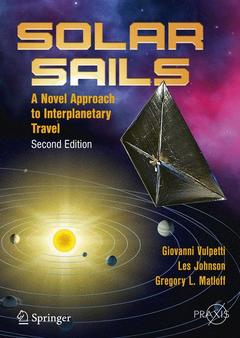Description
Solar Sails (2nd Ed., 2nd ed. 2015)
A Novel Approach to Interplanetary Travel
Space Exploration Series
Authors: Vulpetti Giovanni, Johnson Les, Matloff Gregory L.
Language: English
Subjects for Solar Sails:
42.19 €
In Print (Delivery period: 15 days).
Add to cart277 p. · 16.8x24 cm · Paperback
Description
/li>Contents
/li>Biography
/li>Comment
/li>
Giovanni Vulpetti received his Ph.D. in plasma physics in 1973. Subsequently, he specialized in astrodynamics. He wrote many tens of scientific papers about astrodynamics, advanced propulsion concepts, and interstellar flight, with particular regard to matter-antimatter annihilation propulsion. In 1979, he joined Telespazio SpA (Rome, Italy). From 1995 to 2011, he has attended the committee for Lunar Base & Mars exploration of the International Academy of Astronautics (IAA). He has been involving in solar-photon sailing since 1992. In the 1990s, he found out new types of sailcraft trajectories and published his theory mainly on Acta Astronautica, JPL workshops, and IAA symposia. In 1994, he was elected a Full Member of IAA. In spring 1997, he was a consultant at ESA/ESTEC about the solar-sail mission concept Daedalus. In 1979-2004, he contributed to 11 Italian and European space programs. In 2001, he was a consultant at NASA/MSFC for the NASA Interstellar Probe. In the course of two decades, he accomplished some large computer codes devoted to mission analysis & trajectory optimization via rockets and/or solar-sails. In the 90s, he was a member of the IAA committee for small satellites and, consequently, he participated in the design of Telespazio TemiSat (launched in August 1993). During 2006-2007, he joined Galilean Plus (Rome, Italy) as chief scientist, and participated in the program of the Italian Space Agency for lunar explorations. To date, he has published about 120 research papers and reports. He was a COSPAR-Associate in 2002-2007. In 2009 and 2014, he served as managing guest editor of Acta Astronautica special issues. He wrote the book Fast Solar Sailing, Astrodynamics of Special Sailcraft Trajectories, Space Technology Library 30, Springer 2012. Since spring 2013, he has been a guest lecturer on the physics of in-space propulsion at the Dept. of Astronautical Engineering of University of Rome ‘La Sapienza’.
L
Presents details of space-vehicle propulsion (solar sailing), operations of systems that may use sunlight or solar wind and design and construction of these vehicles
Updated with 35% new material from the first edition, including approximately 40 new figures and three new chapters dedicated to the historical missions operated by Japan and the USA
Written at a level for the general population but interspersed with areas of more technical explanation at an undergraduate level, as was done in the first edition and reviewed as, “By using common nomenclature, the book easily conveys the necessary scientific elements to both a generalist and a space enthusiast” (Mark Mortimer, Universe Today, March, 2009)
Includes supplementary material: sn.pub/extras
These books may interest you

Advances in Solar Sailing 316.49 €



